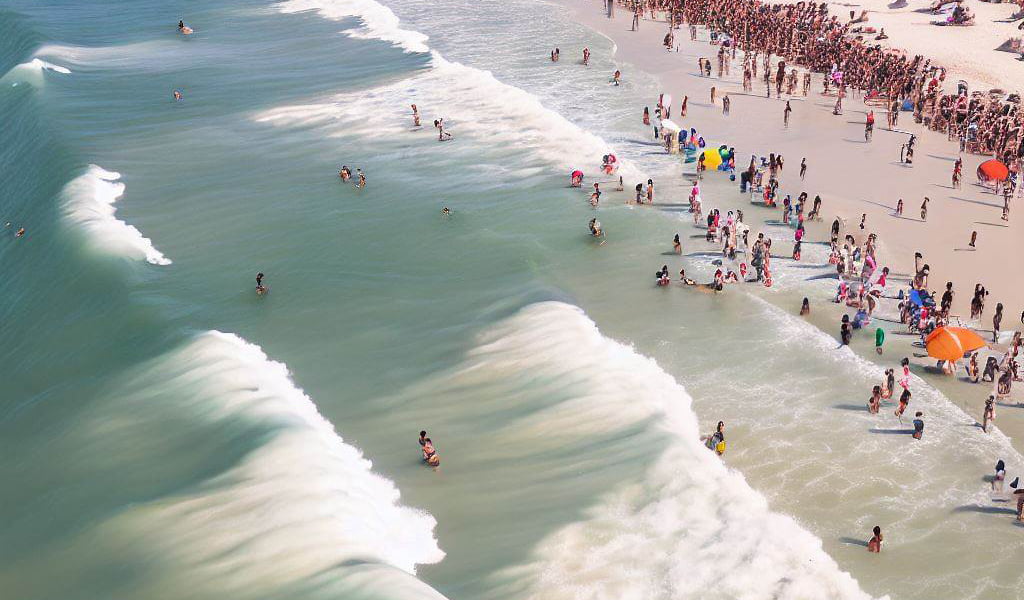When it comes to beach safety, understanding potential water hazards is crucial. One such hazard that beachgoers should be aware of is a rip tide, also known as a rip current.
These powerful currents can pose a significant risk to swimmers, surfers, and even experienced water enthusiasts.
In this article, we will delve into the world of rip tides, exploring their characteristics, dangers, and safety measures to ensure a safer beach experience.
What is a Rip Tide?
A rip tide, often referred to as a rip current, is a strong and narrow channel of water that flows seaward from the shoreline.
It occurs when large amounts of water, accumulated near the shore by incoming waves, are forced to find the path of least resistance back out to sea. This concentrated flow can reach speeds of up to 8 feet per second, which is faster than an Olympic swimmer.
Characteristics of Rip Tides
To better understand the dangers posed by rip tides, it is important to recognize their key characteristics:
- Narrow and Fast-Flowing: Rip currents typically appear as narrow bands of turbulent water that flow against the incoming waves. They can extend from the shoreline up to hundreds of feet offshore and can move at a considerable speed.
- Deceptive Appearance: Rip tides are often difficult to spot, as they may not exhibit the visual cues of churning waves or discoloured water. This can catch swimmers off guard, leading to potential danger.
- Variable Size and Strength: The intensity of rip currents can vary. Some may be weak and easily escapable, while others can be powerful and more challenging to overcome.
Dangers of Rip Tides
Rip tides can pose significant dangers to beachgoers and swimmers:
- Strong Pulling Force: Rip currents have a powerful pulling force that can swiftly carry even the strongest swimmers away from the shore and into deeper waters. This can be particularly dangerous for weaker or inexperienced swimmers who may panic and struggle against the current.
- Exhaustion and Fatigue: Attempting to swim against a rip tide can quickly exhaust even the most capable swimmers. The force of the current can be overpowering, leading to fatigue and potentially increasing the risk of drowning.
- Disorientation: Once caught in a rip current, swimmers may become disoriented and lose their sense of direction. This can make it difficult to swim back to shore or call for help.
Beach Safety Tips: How to Stay Safe
To ensure your safety when enjoying the beach, it’s important to keep the following tips in mind:
- Swim Near Lifeguard Towers: Always swim in areas monitored by lifeguards. They are trained to identify and respond to rip currents promptly.
- Observe Safety Signs and Flags: Pay attention to beach safety signs and flags. These are used to communicate water conditions, including the presence of rip currents.
- Stay Calm and Conserve Energy: If caught in a rip tide, remain calm and conserve your energy. Trying to swim directly back to shore against the current can be exhausting. Instead, swim parallel to the shoreline until you are out of the rip current, and then swim back to the shore.
- Avoid Isolated Areas: Rip currents are more likely to occur in areas with no or fewer breaking waves. Avoid swimming in isolated areas and opt for beaches with active wave patterns.
- Educate Yourself: Learn how to identify rip currents by understanding the visual cues and patterns associated with them. This knowledge can help you make informed decisions about entering the water.
Interesting Facts about Rip Tides
- Rip tides are responsible for the majority of beach rescues performed by lifeguards.
- Rip currents can occur on any beach with breaking waves, including freshwater bodies such as lakes and rivers.
- Rip tides are not the same as undertows. Undertows are a separate phenomenon caused by wave action, while rip tides are driven by the flow of water back out to sea.
5 Popular Questions People ask about Rip Tides
How can you identify a rip tide?
Rip tides are often difficult to visually identify, as they may not display typical signs such as churning waves or discoloured water. Look out for areas of calm or murky water, gaps in breaking waves, or lines of foam, as these can indicate the presence of a rip current.
What should I do if I get caught in a rip tide?
If caught in a rip tide, it’s essential to remain calm and avoid struggling against the current. Swim parallel to the shoreline until you are out of the rip current, and then swim back to the shore. If you’re unable to escape the current, wave for help and conserve your energy.
Are rip tides more dangerous during specific times of the day?
Rip currents can occur at any time, but they are more likely to be hazardous during low tide and when waves are large and powerful. However, it’s important to remember that rip currents can be present at any time, regardless of tidal conditions.
Can rip tides pull you under the water?
Rip tides do not pull swimmers under the water like a whirlpool. Instead, they carry swimmers away from the shore and into deeper waters. The danger lies in the powerful flow and the potential for exhaustion or disorientation.
Can rip tides be predicted?
Rip currents are difficult to predict with pinpoint accuracy. However, lifeguards and coastal authorities rely on weather and wave conditions to provide general warnings and identify areas where rip currents are more likely to occur. Monitoring beach safety signs and flags can help indicate the presence of rip tides.
So now you know more about rip tides and how rip currents pose a serious threat to beachgoers.
Understanding their characteristics, dangers, and how to stay safe is crucial for enjoying the beach responsibly.
By being aware of the signs of rip currents, observing safety guidelines, and practicing caution, you can ensure a safer and more enjoyable beach experience for yourself and others.

